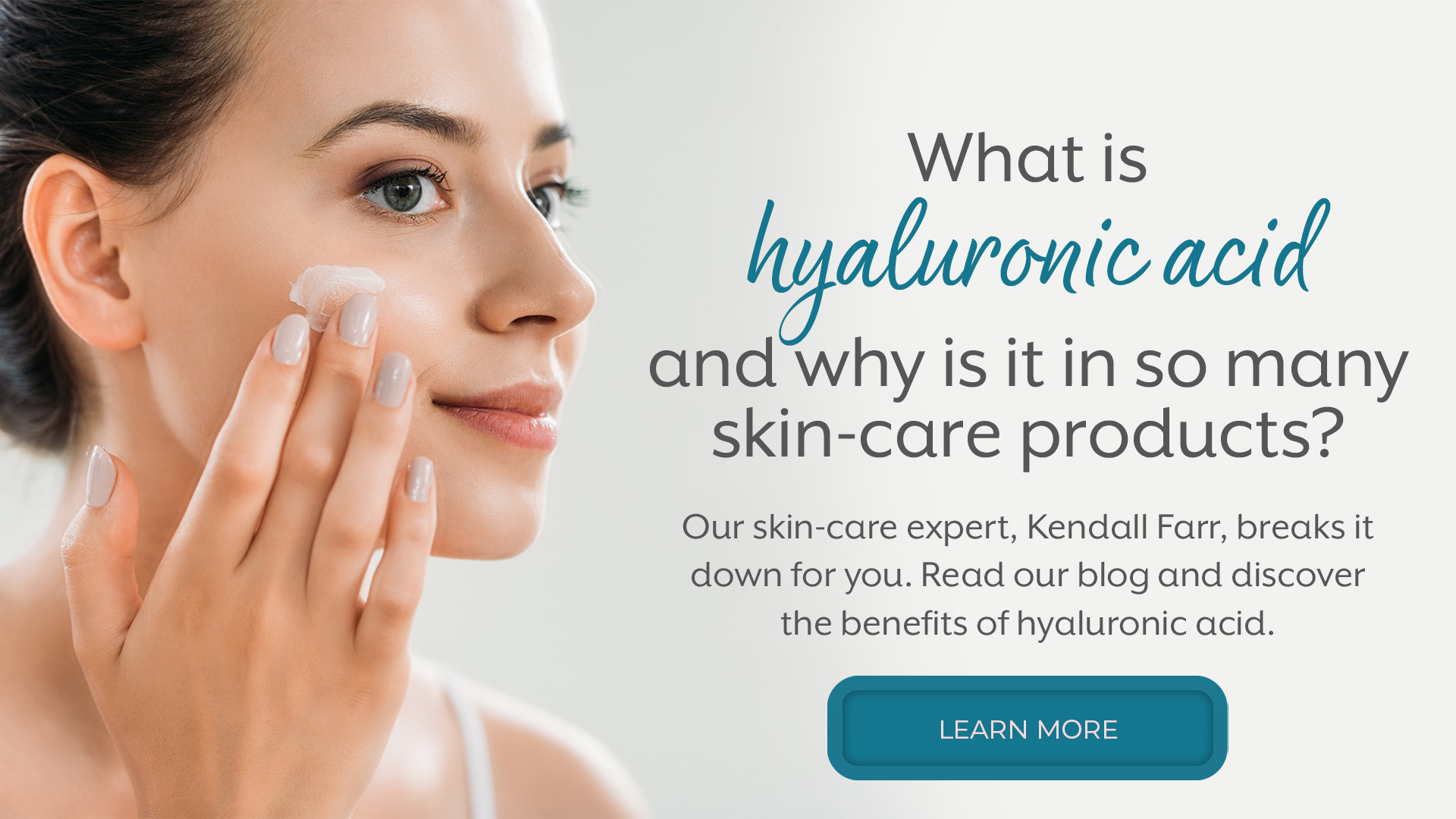By Kendall Farr, Licensed Esthetician, Spada Skincare
Hyaluronic acid (aka HA) is currently the most searched-for skin care ingredient on-line. And with good reason. This super-hydrating wonder can infuse skin with much-needed moisture. And who doesn’t need vital moisture to counteract skin-care concerns like sun exposure, fine lines, loss of elasticity, and dehydrated skin? But currently it seems to be everywhere and added to an array of products. Walk any skin care aisle looking for a truly high-quality hyaluronic acid and you’ll find a head-exploding number of creams, serums, and more billed as including the star ingredient. Here’s what you need to know to find a product that will deliver noticeable results.
What Is Hyaluronic Acid Exactly?
First, the body has a variety of naturally occurring substances in the skin like collagen, elastin, ceramides, and a super humectant known as hyaluronic acid. Hyaluronic acid attracts and holds moisture in the skin by attaching itself to the water in our cells, making them plump. It can draw moisture from the air to keep skin moist, holding almost 1000 times its weight in water. Our bodies produce hyaluronic acid to act as both a cushioning and lubricating agent for our joints, nerves, hair, skin, and eyes, but we produce less of it as we age. This leaves our skin increasingly unable to retain water, which results in dehydration, sallow skin, and ultimately fine lines and wrinkles. This progressive lack of moisture is one of the main culprits in aging skin. Hyaluronic acid is a must-add ingredient for repairing and maintaining healthy, firmer (read younger) looking skin.
Fast Facts About Hyaluronic Acid
- TYPE OF INGREDIENT: It’s a humectant.
- MAIN BENEFITS: It moisturizes the skin, reduces the appearance of wrinkles, and replenishes cell moisture.
- WHO SHOULD USE IT: Hyaluronic acid is safe for all skin types, but it is especially helpful for those with dry skin or for any skin type experiencing dehydration.
- WHEN TO USE IT: Hyaluronic acid can be applied twice a day topically, in the morning and at night during your skincare routine.
- PLAYS WELL WITH: Vitamin C, Retinol, and alpha hydroxy acids like lactic and glycolic.
- BONUS: There are no known negative reactions to hyaluronic acid.
How To Use It
One of the best ways to benefit from Hyaluronic acid is from a serum. Formulas that combine high and low molecular weights like G.M. Collin Hydramucine Optimal Serum offer the deepest penetration because they have enough of what’s described as a ‘molecular load’ to drive the ingredients through the skin’s layers—from your top layer (your barrier) down to your cellular layer (your dermis). The formula also includes a quenching hydration complex with extracts of watermelon and apple to boost the skin’s natural moisture factor (NMF). These combine with hyaluronic acid to deliver long lasting hydration (up to 24 hours) that leaves skin feeling soft and supple. Did I mention skin that glows?
PRO TIP: Always apply an HA serum first after cleansing your skin. To get the most out of your serum, apply it to slightly damp skin before applying other products. After cleansing, use a hydrating mist like G.M. Collin Hydramucine Hydrating Mist and massage it into your skin. Why is this an important step? Because moist skin absorbs up to ten times more product than dry skin. Hydrators like Aloe barbadensis saturate your skin with moisture and prime your face and neck to deeply absorb your serum. After an application of HA serum, follow with a serum like vitamin C during the day. Then apply a moisturizer chosen for your specific skin type to further lock-in needed hydration. You’ll likely notice an immediate improvement in your skin. Long-term benefits are visible as early as two weeks and with continued use, the cumulative effects of Hyaluronic acid produce significant improvement over several months.
State-of-the-Art Skin Plumping
Because there is zero value in applying any ingredient that just sits on the top layer of your skin, G.M. Collin has taken repair to the next level with the introduction of a first-of-its-kind product—Hyaluronic Filler Serum—formulated with ‘cosmetic drone’ technology. Here’s how it works: the drone harnesses the power of oligopeptides that guide the hyaluronic acid to specific areas of the skin, searching out fine lines and enlarged pores. When the drone reaches its target sites, it delivers the HA directly into whatever needs filling. The result is an instant smoothing effect. And the process also encourages the skin’s natural production of HA to help restore barrier hydration. Even better, this targeted HA actively works on restoring activity to ‘senescent’ fibroblastic cells. In translation: senescent cells are aging cells that need an energy boost to produce collagen that supports the skin.
How Much Hyaluronic Acid Should I Use?
When it comes to applying HA, your skin will utilize it more effectively in smaller concentrated doses, used in your morning and night routines. A serum should feel thick and a little gloopy so that it will penetrate all the layers of your skin. Don’t waste time with any hyaluronic acid at low concentrations. You’ll know a serum has a low concentration if it feels thin and watery. In other words, an HA that will penetrate only the top layer of your skin (maybe). Go for the gloop!
Hyaluronic acid has the unique ability to enhance the power of any product you layer on top of it. It’s not only safe to use with all your other products and ingredients (like vitamin C, retinol, and moisturizer) it will increase their effectiveness, making it one of the best additions you can make to your skincare routine.

